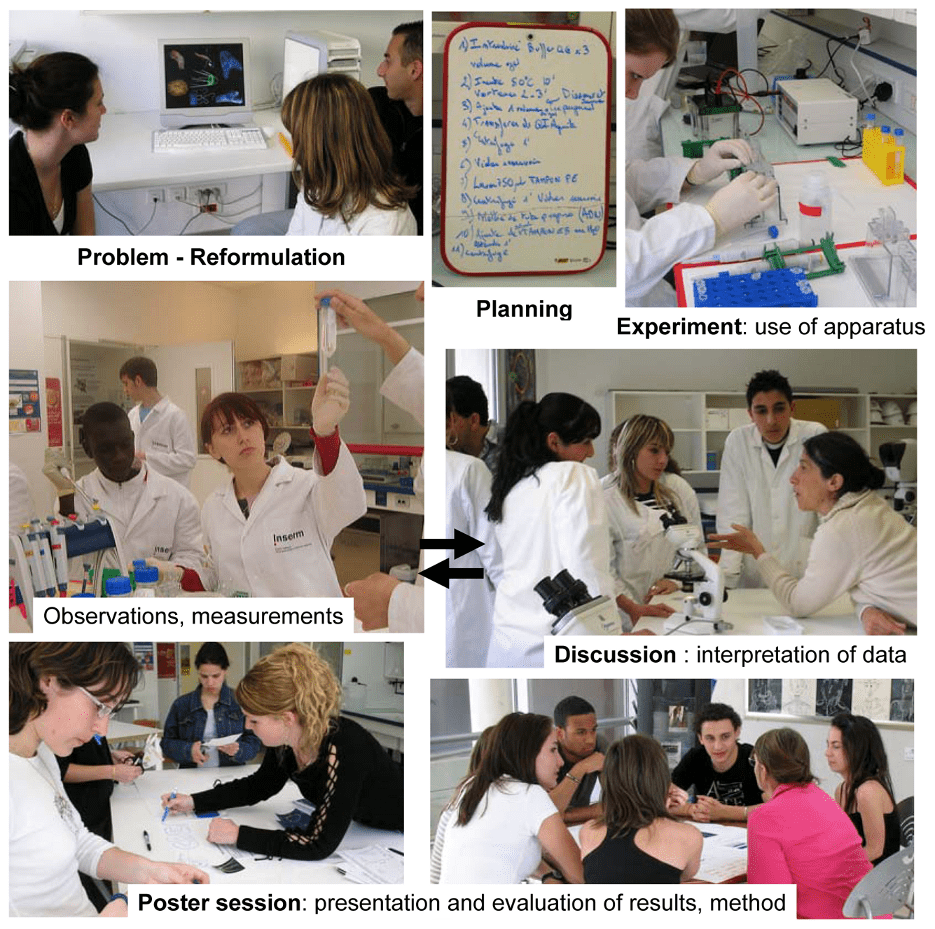The title of this posting refers to the excellent article from David Dobbs I bookmarked very recently. I’d like to present you a very interesting initiative from French bioscience research program for high-school students called “Tous chercheurs”. The Community Page of the very last PLoS Biology is dedicated to this project and I find it really great. Because, indeed, publishing your science paper is only half of the job.
Nowadays, less and less high-school students go into science fields. There are less and less people willing to spend 10 years to complete a PhD degree and even less to spend their lives moving around the world, from a post-doc to post-doc. But this disillusion begins even earlier and here is the motivation of the not-for-profit organization “Tous Chercheurs” and the eponymous high-school students orientated program in life sciences. Indeed, as highlighted by a report from the European Commission, “Europe needs more scientists”. The passive teaching style of natural and life sciences makes the students lose the curiosity and do not allow them to develop critical thinking and rigor indispensable when going into science. In brief: the spell is gone. Definitely.
And this is really awful. I guess many of us have been struggling not to lose this passion and acquire the criticism needed for doing research without becoming a dogmatic rigid boffin. And my guess is also that in such difficult moments, many of us have thought about a person we admire. So, the question is: how may we show those students that doing science is not just being struggling and underpaid all our life and that it is a lot of fun to be on the bench/in front of the computer? Disillusions die hard.
To fight the disenchantment and offer high-school students means to explore the world such as scientists do, a not-for-profit organization based in the south of France is working jointly with the Aix-Marseille University. The latter hosts a dedicated center within the Inmed (Institut de neurobiologie de la méditerranée), a part of the French medical research council (Inserm). “Tous chercheurs” may be loosely translated as “All Researchers” and reflects the idea that “everyone can be a researcher for at least a little while”. Every year since nearly 6 years, high-school students are welcome to participate in “miniature” research projects: something like 3-day internship in a lab. Their life sciences teacher is also present and PhD students from the hosting lab also help for teaching and discussion thus learning how to teach science in an inspiring fashion.
How is this mini-research organized? There are 3 main landmark steps (Fig. 1):
- “observation, creation, and understanding of a problem, what to study, and how to proceed;”
- “experimentation, quantification, and discussion of the results;”
- “interpretation and critical oral presentation of the results.”

Fig. 1. The three-day open-ended investigation including iterative approach between experimentation and interpretation of data (arrows). doi:10.1371/journal.pbio.1000447.g001
Thematic workshops are created corresponding to the French national curriculum which “allow the students to focus on the research processus rather than absorbing complex concepts”. The topics range widely: genetics & molecular biology (GFP purification and expression), immunology (cellular cooperation in immune response), neuroscience (brain development and plasticity), ecology & sustainable development (mitigation of aquatic pollution), etc.
In practice, high-school students are first organized into 3 to 5 groups by their life-sciences teacher and a PhD tutor is attributed to each. The same biological phenomenon is observed by each group and the students think about, the tutor being there to answer their questions but do not impose a direction. Despite students’ surprise of such an approach, free discussions among them are quickly started and they begin generating hypotheses and proposing general protocols to test them. The tutor proposes that a different and complementary research question is tested by each group in order to obtain a coherent ensemble of the 4 questions.
The experiments are conducted by the students between the 1st afternoon and the 3rd morning. Students learn how to read and follow a written protocol, what is a control and how to design it, to discuss their results continuously and redo some of the experiments if necessary. The tutor shows them how to use the facilities and insures through discussions with the students that they have dealt with artifacts and interpreted the data to be able to establish reliable and well-supported conclusions.
Each group prepare several slides summarizing their questions, hypotheses, experimental workflow and conclusions. Those are presented to the others and more explanations are provided by senior researchers. Afterwards, new “chimera” groups are composed with at least one student from each of the previous teams. Their aim is at designing a poster which summarizes the various investigations being performed and their outputs and provides a global overview of the the issue. Each poster originating from those chimera groups are presented to researchers from the field who have not participated to the mini-lab work and the posters are discussed with. Finally, students and researchers retrospectively analyze how they could have improved their approaches.
The paper ends with a quite detailed explanation of how students and tutors are recruited. A preliminary result for enrollement in science of one cohort is also given: 74% of those who passed the French Baccalauréat (the equivalent of A level in the UK or college entrance exam in the USA) are majoring in science at the science or engineering universities. Authors conclude the paper by citing several other institutions which offer high-school students the opportunity to conduct experimental science in a dedicated lab in a campus:
- XLAB (http://www.xlab-goettingen.de/), Germany;
- Life Lab (http://www.lifelab.de/), Germany;
- Gläsernes Labor (http://www.glaesernes-labor.de/), Germany;
- Open Lab (http://www.viennaopenlab.at/), Austria;
- House of Science (http://www.houseofscience.se/), Sweden;
- Petnica Science Center (http://www.psc.ac.yu/eng/), Serbia.
All “share the common goal of encouraging high school students to choose scientific careers”.
And you, what are you doing to make people around be passionate about science? 🙂
![]()
Hammond, C., Karlin, D., & Thimonier, J. (2010). Creative Research Science Experiences for High School Students PLoS Biology, 8 (9) DOI: 10.1371/journal.pbio.1000447

Comments are closed.